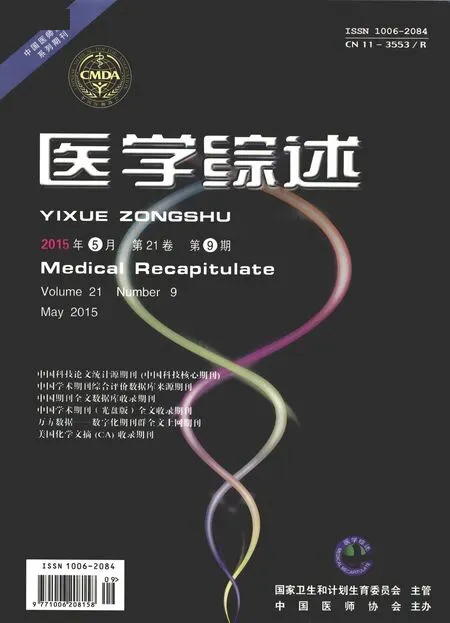癌症患者导管相关血栓形成的防治
石建平,赵梦华(综述),徐宝元(审校)
(邯郸市中心医院心内科,河北 邯郸 056001)
癌症患者导管相关血栓形成的防治
石建平,赵梦华(综述),徐宝元(审校)
(邯郸市中心医院心内科,河北 邯郸 056001)
摘要:临床治疗癌症患者时为了给予化疗药物、血液制品和胃肠道外营养,常给患者置入中心静脉导管,而血栓形成是置入导管后的常见并发症。导管相关血栓形成(CRT)可导致肺栓塞、感染以及导管故障。大部分CRT并无症状,因此需要临床医师对此并发症提高警觉。CRT的诊断依赖于多普勒超声或静脉造影检查,一旦确诊,需权衡抗凝治疗风险与CRT并发症风险后再行决定治疗策略。
关键词:癌症;静脉血栓形成;中心静脉导管;抗凝治疗
越来越多的癌症患者由于需要给予化疗药物、血液制品和胃肠道外营养,而被置入中心静脉导管[1]。静脉血栓栓塞症(venous thromboembolism,VTE)是癌症患者的常见并发症,虽然癌症患者中的大部分VTE为下肢深静脉血栓形成,但也不乏导管相关静脉血栓形成(catheter related thrombosis,CRT)。研究表明,CRT的总体发生率为14%~18%,症状性CRT发生率约为5%[2]。CRT的并发症包括肺栓塞、感染和导管故障。现对癌症患者发生CRT的危险因素、CRT的诊断、预防和治疗策略予以综述。
1CRT的危险因素
1.1置入操作相关危险因素置入操作时对血管壁的损伤可造成血管内皮细胞功能紊乱,从而导致血栓形成。不同血管入路置入导管时对血管内皮损伤的程度并不相同,因此血管入路部位也是发生CRT的重要决定因素。研究表明,从左侧血管置入的中心静脉导管(central venous catheter,CVC)发生CRT的风险高于右侧CVC,而从股静脉置入的CVC比从锁骨下静脉和颈静脉置入的CVC有更高的血栓形成风险[3]。此外,多次置入操作以及既往CVC置入也会增加CRT发生的风险[4]。
1.2导管相关危险因素CVC的化学组成对血栓形成亦有影响,聚乙烯导管比新的多聚体(如聚乌拉坦)有更高的致血栓性;同样,导管的硬度也十分重要,硬导管特别是临时性CVC更易损伤血管壁,而柔软性导管则具有更好的顺应性[5]。导管头端的位置也显著影响CRT的发生率,导管头端如位于上腔静脉较高的位置时易发生血栓形成[6]。有一前瞻性观察性研究表明,经外周血管置入的CVC有较高的导管头端位置异常发生率[7];其CRT发生率为2%~7%[8]。经头静脉置入导管的血栓形成发生率最高(7%),而经贵要静脉和肱静脉置入导管的血栓形成发生率分别为5%和2%[9]。
1.3患者相关危险因素患者相关危险因素包括既往VTE史[3]、遗传性血栓形成倾向[10]、感染[11]以及恶性肿瘤的类型[12]。遗传性血栓形成倾向与CRT的相关性目前尚存在较大的争议[5],而更多的学者现已接受急性感染是VTE的独立危险因素[13]。实体器官肿瘤特别是卵巢癌,比淋巴瘤、骨髓瘤和白血病有更高发生CRT的风险[4]。
2诊断
大部分CRT并无症状,因而其诊断具有一定的挑战性。CRT的症状包括上肢、颈部或面部肿胀疼痛,上肢、颈部或胸壁的红斑、头痛以及上肢静脉曲张等[14]。无症状血栓形成可在行CT或探查导管是否通畅时被发现。对无症状CRT的初始影像学检查应首选双功超声检查[15]。双功超声对累及颈、腋、锁骨下远端和上肢静脉血栓形成的诊断灵敏度为97%,特异度为96%[16]。由于解剖学的关系,双功超声对诊断上腔静脉、锁骨下近端和头臂静脉血栓形成则较为困难。CRT的金标准诊断检查方法为静脉造影[14],考虑到对比剂毒性和放射暴露的风险,所以此种检查应保留给临床高度怀疑但双功超声检查为阴性结果的患者。而增强CT则对深部中央静脉和肺动脉血管床的血栓栓塞具有准确诊断的优势[5]。不同于D-二聚体对下肢深静脉血栓形成和肺栓塞的提示诊断作用,D-二聚体对临床怀疑CRT患者的诊断价值尚不明确;此外,由于癌症患者具有较高的D-二聚体假阳性发生率,故也限制了此项检查在该患者群中的应用[17]。
3并发症
CRT最严重的并发症是肺栓塞,有症状肺栓塞的发生率为5%~14%,而无症状肺栓塞的发生率为15%~36%[5]。CRT最常见的并发症为感染。CRT的长期并发症为血栓形成后综合征,其发生率可高达35%[18]。血栓形成后综合征的临床表现包括肢体疼痛、沉重感、肿胀、痉挛、水肿、静脉曲张以及溃疡。
4预防
4.1冲洗为维持导管的通畅性,需在每次操作后冲洗导管,而未行操作则至少每周需冲洗导管1次[5]。虽然许多临床医师推荐使用肝素进行冲洗,但支持此种方法的证据较少见。事实上使用肝素(10 U/mL)冲洗维持CVC通畅性的效果并不优于生理盐水冲洗[19]。此外,使用肝素冲洗尚存在可能引起肝素诱导的血小板减少的风险。
4.2维生素K拮抗剂早年对置入CVC的癌症患者给予小剂量华法林(1 mg/d)以预防CRT的方法曾经非常流行,但随后的随机安慰剂对照研究并未能证明此方法的有效性[20]。迄今为止,最大的试验WARP研究将置入CVC的癌症患者分为未服用华法林组、小剂量华法林组和调整剂量华法林组(国际标准化比率:1.5~2.0)以观察华法林预防CRT的效果;结果表明,未服用华法林组和小剂量华法林组的CRT发生率无差别;虽然调整剂量华法林组可降低CRT发生率,但却明显增加主要出血的发生率[21]。因此,当今的指南不再推荐使用华法林预防CRT[22-23]。
4.3普通肝素有一随机试验将置入CVC的癌症患者分为接受连续性静脉输注预防性剂量普通肝素组[100 IU/(kg·d)]和生理盐水组(500 mL/d),结果表明,普通肝素组CRT的发生率为1.5%,生理盐水组为12.6%(P=0.03)[24]。但此种方法每日需静脉输注的不方便性限制了其临床应用。
4.4低分子肝素对低分子肝素预防CRT随机对照试验进行汇总分析的结果表明,低分子肝素并不能有效地降低有症状CRT的发生率(RR=0.54,95%CI0.28~1.05),但对主要出血风险亦无明显影响(RR=0.68,95%CI0.10~4.78)[5]。最近的指南指出,虽然低分子肝素用于预防癌症患者CRT时不增加主要出血风险,但也并无明确获益[22-23]。
5治疗
当导管发生阻塞即便并无症状提示为CRT所致时,也应将稀释后的5000 U尿激酶注入导管腔并保留2 h[25]。如导管仍然阻塞则应行胸部X线检查以证实导管的位置并除外发生阻塞的机械性原因,然后再注入5000 U尿激酶并保留12~24 h[5]。由于治疗性剂量纤溶药物可增加主要出血风险并缺乏长期获益的证据,所以对可疑或确诊的CRT不推荐给予治疗性剂量纤溶药物[15]。有一小型非随机前瞻性研究对74例经放射学检查确诊的CRT实体肿瘤患者给予了3个月抗凝治疗,结果表明,32例(43%)患者移除了CVC,3例(4%)发生了再发CRT,7例(9%)发生了主要出血事件[26]。虽然对癌症患者CRT给予抗凝治疗的证据较为有限,但大部分学者认为应至少给予3个月的抗凝治疗[23]。对正在接受化疗和抗生素治疗的癌症患者很难保证华法林抗凝治疗的安全性,另外基于低分子肝素治疗癌症患者VTE无可争议的获益证据,所以对癌症患者CRT的抗凝治疗推荐给予低分子肝素[27]。由于仅对少数VTE患者给予新型口服抗凝药物治疗,对CRT患者尚无应用此类药物的报道,所以目前尚不能对新型口服抗凝药物用于治疗癌症患者CRT做出评论[2,28]。血小板减少症是CRT患者给予抗凝治疗时需考虑的一个重要问题,特别是对正在接受骨髓抑制剂治疗的患者则更为重要,指南推荐血小板计数>80×109/L时可给予全剂量抗凝治疗[29]。而在临床实践中,更多的临床医师对血小板计数>50×109/L的患者给予全剂量抗凝治疗;对血小板计数为30×109/L~50×109/L的患者给予小剂量抗凝治疗;对血小板计数<30×109/L的患者则不给予抗凝治疗[30]。如果仍然需要CVC,导管的功能和位置亦正常,同时无导管相关感染的迹象时,当今的指南不推荐移除CVC[22-23]。但如果不符合上述任一标准时则应移除CVC。移除导管的最佳时间目前尚无明确的结论,临床通常是在给予抗凝治疗后的3~5 d移除导管[2]。
6小结
大部分癌症患者的CRT并无症状,因此为了及时诊断和治疗需要应对此并发症给予高度的警觉。CRT的危险因素包括置入操作因素、导管相关因素和患者相关危险因素。虽然CRT的诊断金标准为静脉造影,但多数患者行静脉超声和CT检查即可得到明确诊断。一旦确诊为CRT,至少需给予低分子肝素抗凝治疗3个月。如果需要保留CVC,而CVC仍通畅且无感染的证据时,应避免移除导管。对怀疑为CRT的癌症患者可不行D-二聚体检查。对需要置入CVC的癌症患者可不行遗传性血栓形成倾向筛查及常规给予血栓预防措施。
参考文献
[1]Piazza G.Venous thromboembolism and cancer[J].Circulation,2013,128(24):2614-2618.
[2]Kamphuisen PW,Lee AY.Catheter-related thrombosis:lifeline or a pain in the neck?[J].Hematology Am Soc Hematol Educ Program,2012,2012:638-644.
[3]Saber W,Moua T,Williams EC,etal.Risk factors for catheter-related thrombosis(CRT)in cancer patients:a patientlevel data (IPD) meta-analysis of clinical trials and prospective studies[J].J Thromb Haemost,2011,9(2):312-319.
[4]Lee AY,Levine MN,Butler G,etal.Incidence,risk factors,and outcomes of catheterrelated thrombosis in adult patients with cancer[J].J Clin Oncol,2006,24(9):1404-1408.
[5]Murray J,Precious E,Alikhan R,etal.Catheter-related thrombosis in cancer patients[J].Br J Haematol,2013,162(6):748-757.
[6]Verso M,Agnelli G,Kamphuisen PW,etal.Risk factors for upper limb deep vein thrombosis associated with the use of central vein catheter in cancer patients[J].Intern Emerg Med,2008,3(2):117-122.
[7]Kim HJ,Yun J,Kim KH,etal.Safety and effectiveness of central venous catheterization in patients with cancer:prospective observational study[J].J Korean Med Sci,2010,25(12):1748-1753.
[8]Aw A,Carrier M,Koczerginski J,etal.Incidence and predictive factors of symptomatic thrombosis related to peripherally inserted central catheters in chemotherapy patients[J].Thromb Res,2012,130(3):323-326.
[9]Liem TK,Yanit KE,Moseley SE,etal.Peripherally inserted central catheter usage patterns and associated symptomatic upper extremity venous thrombosis[J].J Vasc Surg,2012,55(3):761-767.
[10]Dentali F,Gianni M,Agnelli G,etal.Association between inherited thrombophilic abnormalities and central venous catheter thrombosis in patients with cancer:a meta-analysis[J].J Thromb Haemost,2008,6(1):70-75.
[11]Van Rooden CJ,Schippers EF,Barge RM,etal.Infectious complications of central venous cathers increase the risk of catheter-related thrombosis in hematology patients:a prospective study[J].J Clin Oncol,2005,23(12):2655-2660.
[12]Shivakumar SP,Anderson DR,Couban S.Catheter-associated throm- bosis in patients with malignancy[J].J Clin Oncol,2009,27(29):4858-4864.
[13]Schmidt M,Horvath-Puho E,Thomsen RW,etal.Acute infections and venous thromboembolism[J].J Intern Med,2012,271(6):608-618.
[14]Baskin JL,Pui CH,Reiss U,etal.Management of occlusion and thrombosis associated with long-term indwelling central venous catheters[J].Lancet,2009,374(9684):159-169.
[15]Kearon C,Akl EA,Comerota AJ,etal.Antithrombotic therapy for VTE disease:Antithrombotic Therapy and Prevention of Thrombosis,9th ed:American College of Chest Physicians Evidence-Based Clinical Practice Guidelines[J].Chest,2012,141(2 Suppl):e419s-494s.
[16]Di Nisio M,Van Sluis GL,Bossuyt PM,etal.Accuracy of diagnostic tests for clinically suspected upper extremity deep vein thrombosis:a systematic review[J].J Thromb Haemost,2010,8(4):684-692.
[17]Sohne M,Kruip MJ,Nijkeuter M,etal.Accuracy of clinical decision rule,D-dimer and spiral computed tomography in patients with malignancy,previous venous thromboembolism, COPD or heart failure and in older patients with suspected pulmonary embolism[J].J Thromb Haemost,2006,4(5):1042-1046.
[18]Massoure PL,Constans J,Caudry M,etal.Upper extremity deep venous thrombosis.40 hospitalized patients[J].J Mal Vasc,2000,25(4):250-255.
[19]Mitchell MD,Anderson BJ,Williams K,etal.Heparin flushing and other interventions to maintain patency of central venous catheters:a systematic review[J].J Adv Nurs,2009,65(10):2007-2021.
[20]Couban S,Goodyear M,Burnell M,etal.Randomized placebo-controlled study of low-dose warfarin for the prevention of central venous catheter-associated thrombosis in patients with cancer[J].J Clin Oncol,2005,23(18):4063-4069.
[21]Young AM,Billingham LJ,Begum G,etal.Warfarin thromboprophylaxis in cancer patients with central venous catheters (WARP):an open-label randomised trial[J].Lancet,2009,373(9663):567-574.
[22]Kahn SR,Lim W,Dunn AS,etal.Prevention of VTE in nonsurgical patients:Antithrombotic Therapy and Prevention of Thrombosis,9th ed:American College of Chest Physicians Evidence-Based Clinical Practice Guidelines[J].Chest,2012,141(Suppl 2):195s-226s.
[23]Debourdeau P,Farge D,Beckers M,etal.International clinical practice guidelines for the treatment and prophylaxis of thrombosis associated with central venous catheters in patients with cancer[J].J Thromb Haemost,2013,11(1):71-80.
[24]Abdelkefi A,Ben Othman T,Kammoun L,etal.Prevention of central venous line-related thrombosis by continuous infusion of low-dose unfractionated heparin,in patients with haemato-oncological disease[J].Thromb Haemost,2004,92(3):654-661.
[25]Baskin JL,Reiss U,Wilimas JA,etal.Thrombolytic therapy for central venous catheter occlusion[J].Haematologica,2012,97 (5):641-650.
[26]Kovacs MJ,Kahn SR,Rodger M,etal.A pilot study of central venous catheter survival in cancer patients using low-molecular-weight heparin (dalteparin) and warfarin without catheter removal for the treatment of upper extremity deep vein thrombosis (The Catheter Study)[J].J Thromb Haemost,2007,5(8):1650-1653.
[27]Lee AY,Levine MN,Baker RI,etal.Low-molecular-weight heparin versus a coumarin for the prevention of recurrent venous thromboembolism in patients with cancer[J].N Engl J Med,2003,349(2):146-153.
[28]Kucher N.Clinical practice.Deep-vein thrombosis of the upper extremities[J].N Engl J Med,2011,364(9):861-869.
[29]Baglin T,Barrowcliffe TW,Cohen A,etal.Guidelines on the use and monitoring of heparin[J].Br J Haematol,2006,133(1):19-34.
[30]Bishop L,Dougherty L,Bodenham A,etal.Guidelines on the insertion and management of central venous access devices in adults[J].Int J Lab Hematol,2007,29(4):261-278.
Study on the Prevention and Treatment of Catheter-Related Thrombosis in Cancer PatientsSHIJian-ping,ZHAOMeng-hua,XUBao-yuan.(DepartmentofCardiology,HandanCentralHospital,Handan056001,China)
Abstract:Central venous catheters are commonly used for the administration of chemotherapy,blood products and parenteral nutrition in patients with haematological malignancy.Thrombosis is a recognized complication of the placement of such devices especially in oncology patients.Catheter-related thrombi(CRT) may lead to pulmonary embolism and infection,as well as catheter failure and potential delays in treatment.The vast majority of CRT are asymptomatic,thus a high index of suspicion is required in making the diagnosis.Doppler ultrasound or venography may be employed to identify CRT.Once confirmed,the initiation of treatment needs to balance between the risk of anticoagulation and potential complications of CRT.
Key words:Cancer; Venous thrombosis; Central venous catheter; Anticoagulation
收稿日期:2014-07-08修回日期:2014-10-31编辑:郑雪
doi:10.3969/j.issn.1006-2084.2015.09.025
中图分类号:R473.73
文献标识码:A
文章编号:1006-2084(2015)09-1602-03

